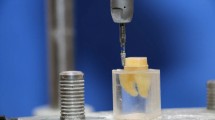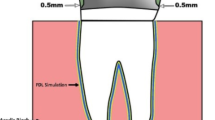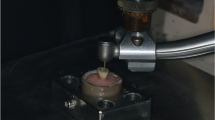Abstract
The aim of the study was to evaluate the influence of fatigue and cementation mode on the fracture behavior of endodontically treated bovine incisors restored with zirconium dioxide posts and crowns. Forty-eight endodontically treated bovine primary incisors were restored with zirconium dioxide posts (Cerapost, Brasseler), composite build-ups, and crowns cast from a chromium cobalt alloy. In 16 teeth, each of the posts was cemented conventionally with KetacCem (3M ESPE) or adhesively with Panavia F (Kuraray) or RelyX UniCem (3M ESPE). One-half of the specimens in each group were subjected to thermocycling with 10,000 cycles at 5–55°C and mechanical aging, loading the specimens at an angle of 45° in 1,200,000 cycles with 50 N. Fracture resistance was determined by loading the specimens until fracture at an angle of 45° to the long axis of the teeth. The loading test showed that neither cementation mode nor fatigue testing had an influence on the load bearing capability. Most specimens fractured in a favorable way, independent from the type of cementation.

Similar content being viewed by others
References
Bachicha WS, DiFiore PM, Miller DA, Lautenschlager EP, Pashley DH (1998) Microleakage of endodontically treated teeth restored with posts. J Endod 24:703–708
Bitter K, Paris S, Martus P, Schartner R, Kielbassa AM (2004) A confocal laser scanning microscope investigation of different dental adhesives bonded to root canal dentine. Int Endod J 37:840–848
Bitter K, Meyer-Lueckel H, Priehn K, Kanjuparambil JP, Neumann K, Kielbassa AM (2006) Effects of luting agent and thermocycling on bond strengths to root canal dentine. Int Endod J 39:809–818
Bitter K, Priehn K, Martus P, Kielbassa AM (2006) In vitro evaluation of push-out bond strengths of various luting agents to tooth-colored posts. J Prosthet Dent 95:302–310
Blatz MB, Chiche G, Holst S, Sadan A (2007) Influence of surface treatment and simulated aging on bond strengths of luting agents to zirconia. Quintessence Int 38:745–753
Bottino MA, Baldissara P, Valandro LF, Galhano GA, Scotti R (2007) Effects of mechanical cycling on the bonding of zirconia and fiber posts to human root dentin. J Adhes Dent 9:327–331
de la Macorra JC, Pradies G (2002) Conventional and adhesive luting cements. Clin Oral Investig 6:198–204
Derand P, Derand T (2000) Bond strength of luting cements to zirconium oxide ceramics. Int J Prosthodont 13:131–135
Dietschi D, Ardu S, Rossier-Gerber A, Krejci I (2006) Adaptation of adhesive post and cores to dentin after in vitro occlusal loading: evaluation of post material influence. J Adhes Dent 8:409–419
Duret B, Duret F, Reynaud M (1996) Long-life physical property preservation and postendodontic rehabilitation with the Composipost. Compend Contin Educ Dent 20(Suppl):S50–S56
Fernandes AS, Shetty S, Coutinho I (2003) Factors determining post selection: a literature review. J Prosthet Dent 90:556–562
Ferrari M, Mannocci F, Vichi A, Cagidiaco MC, Mjor IA (2000) Bonding to root canal: structural characteristics of the substrate. Am J Dent 13:255–260
Ferrari M, Vichi A, Garcia-Godoy F (2000) Clinical evaluation of fiber-reinforced epoxy resin posts and cast post and cores. Am J Dent 13:15B–18B
Ferrari M, Vichi A, Grandini S (2001) Efficacy of different adhesive techniques on bonding to root canal walls: an SEM investigation. Dent Mater 17:422–429
Fokkinga WA, Kreulen CM, Vallittu PK, Creugers NH (2004) A structured analysis of in vitro failure loads and failure modes of fiber, metal, and ceramic post-and-core systems. Int J Prosthodont 17:476–482
Fokkinga WA, Kreulen CM, Le Bell-Ronnlof AM, Lassila LV, Vallittu PK, Creugers NH (2006) In vitro fracture behavior of maxillary premolars with metal crowns and several post-and-core systems. Eur J Oral Sci 114:250–256
Goodis HE, Marshall GW Jr., White JM, Gee L, Hornberger B, Marshall SJ (1993) Storage effects on dentin permeability and shear bond strengths. Dent Mater 9:79–84
Grandini S, Goracci C, Tay FR, Grandini R, Ferrari M (2005) Clinical evaluation of the use of fiber posts and direct resin restorations for endodontically treated teeth. Int J Prosthodont 18:399–404
Haller B, Hofmann N, Klaiber B, Bloching U (1993) Effect of storage media on microleakage of five dentin bonding agents. Dent Mater 9:191–197
Heydecke G, Butz F, Hussein A, Strub JR (2002) Fracture strength after dynamic loading of endodontically treated teeth restored with different post-and-core systems. J Prosthet Dent 87:438–445
Isidor F, Brondum K (1992) Intermittent loading of teeth with tapered, individually cast or prefabricated, parallel-sided posts. Int J Prosthodont 5:257–261
Isidor F, Odman P, Brondum K (1996) Intermittent loading of teeth restored using prefabricated carbon fiber posts. Int J Prosthodont 9:131–136
Krejci I, Reich T, Lutz F, Albertoni M (1990) An in vitro test procedure for evaluating dental restoration systems. 1. A computer-controlled mastication simulator. Schweiz Monatsschr Zahnmed 100:953–960
Kwiatkowski S, Geller W (1989) A preliminary consideration of the glass-ceramic dowel post and core. Int J Prosthodont 2:51–55
Lanza A, Aversa R, Rengo S, Apicella D, Apicella A (2005) 3D FEA of cemented steel, glass and carbon posts in a maxillary incisor. Dent Mater 21:709–715
Mannocci F, Ferrari M, Watson TF (1999) Intermittent loading of teeth restored using quartz fiber, carbon-quartz fiber, and zirconium dioxide ceramic root canal posts. J Adhes Dent 1:153–158
Meyenberg H, Lüthy H, Schärer P (1995) Zirconia posts: a new all-ceramic concept for nonvital abutment teeth. J Esthet Dent 7(2):73–80
Mezzomo E, Massa F, Libera SD (2003) Fracture resistance of teeth restored with two different post-and-core designs cemented with two different cements: an in vitro study. Part I. Quintessence Int 34:301–306
Morgano SM, Brackett SE (1999) Foundation restorations in fixed prosthodontics: current knowledge and future needs. J Prosthet Dent 82:643–657
Nakamichi I, Iwaku M, Fusayama T (1983) Bovine teeth as possible substitutes in the adhesion test. J Dent Res 62:1076–1081
Nissan J, Dmitry Y, Assif D (2001) The use of reinforced composite resin cement as compensation for reduced post length. J Prosthet Dent 86:304–308
Nissan J, Parson A, Barnea E, Shifman A, Assif D (2007) Resistance to fracture of crowned endodontically treated premolars restored with ceramic and metal post systems. Quintessence Int 38:e120–e123
Nothdurft FP, Pospiech PR (2006) Clinical evaluation of pulpless teeth restored with conventionally cemented zirconia posts: a pilot study. J Prosthet Dent 95:311–314
Nothdurft FP, Seidel E, Gebhart F, Naumann M, Motter PJ, Pospiech PR (2008) Influence of endodontic posts on the fracture behavior of crowned premolars with class II cavities. J Dent 36:287–293
Ozcan M, Vallittu PK (2003) Effect of surface conditioning methods on the bond strength of luting cement to ceramics. Dent Mater 19:725–731
Paul SJ, Werder P (2004) Clinical success of zirconium oxide posts with resin composite or glass-ceramic cores in endodontically treated teeth: a 4-year retrospective study. Int J Prosthodont 17:524–528
Pospiech P (2002) All-ceramic crowns: bonding or cementing? Clin Oral Investig 6:189–197
Reid LC, Kazemi RB, Meiers JC (2003) Effect of fatigue testing on core integrity and post microleakage of teeth restored with different post systems. J Endod 29:125–131
Rueggeberg FA (1991) Substrate for adhesion testing to tooth structure—review of the literature. Dent Mater 7:2–10
Sung EC, Tai ET, Chen T, Caputo AA (2002) Effect of irrigation solutions on dentin bonding agents and restorative shear bond strength. J Prosthet Dent 87:628–632
Tjan AH, Nemetz H (1992) Effect of eugenol-containing endodontic sealer on retention of prefabricated posts luted with adhesive composite resin cement. Quintessence Int 23:839–844
Torbjorner A, Fransson B (2004) A literature review on the prosthetic treatment of structurally compromised teeth. Int J Prosthodont 17:369–376
Usumez A, Cobankara FK, Ozturk N, Eskitascioglu G, Belli S (2004) Microleakage of endodontically treated teeth with different dowel systems. J Prosthet Dent 92:163–169
Valderhaug J, Jokstad A, Ambjornsen E, Norheim PW (1997) Assessment of the periapical and clinical status of crowned teeth over 25 years. J Dent 25:97–105
Wegner SM, Kern M (2000) Long-term resin bond strength to zirconia ceramic. J Adhes Dent 2:139–147
Yoshiyama M, Carvalho RM, Sano H, Horner JA, Brewer PD, Pashley DH (1996) Regional bond strengths of resins to human root dentine. J Dent 24:435–442
Zalkind M, Hochman N (1998) Esthetic considerations in restoring endodontically treated teeth with posts and cores. J Prosthet Dent 79:702–705
Conflict of interest statement
The authors declare that they have no conflict of interest.
Author information
Authors and Affiliations
Corresponding author
Rights and permissions
About this article
Cite this article
Nothdurft, F.P., Schmitt, T., Motter, P.J. et al. Influence of fatigue testing and cementation mode on the load-bearing capability of bovine incisors restored with crowns and zirconium dioxide posts. Clin Oral Invest 12, 331–336 (2008). https://doi.org/10.1007/s00784-008-0205-9
Received:
Accepted:
Published:
Issue Date:
DOI: https://doi.org/10.1007/s00784-008-0205-9




